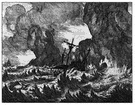Pedro Alvares Cabral and the Discovery of Brazil
Part 2: The Famous Voyage They shipped out from Lisbon on March 9, 1500, following Vasco Da Gama's route to India. They ventured off-course a good bit to the west and saw land that turned out to be South America. Were they the victims of unusually strong currents or winds? Was Cabral looking to restake a claim to South America, a claim that was begun with the Treaty of Tordesillas in 1494? No one can say for sure. We do know, however, that Cabral and his men did see land that turned out to be Brazil and that they did set foot on this land in April 1500. Cabral called this land Vera Cruz ("Island of the True Cross") and made every effort to make friends with the men and women living there. He invited them onboard his ships, he traded goods with them. Nonetheless, he claimed the land in the name of King Manuel I of Portugal. After a few days, the Portuguese set out again in search of India.
At this time, one would think that Cabral would be as much of a hero as Da Gama. This was not the case. No sources tell us what happened, but for some reason Cabral fell out of favor with the king. The next voyages to India were captained by Da Gama and others, not Cabral. Pedro Álvares Cabral, the discoverer of Brazil, vanished from the ship logs and the pages of history. No one for sure knows when he died. He was buried in a monastery in Santarem, Portugal. First page > The Early Years > Page 1, 2 |
|
Social Studies for Kids
copyright 2002–2025
David White



 They survived a series of adventures at sea and arrived in Calicut, India, (where Da Gama had first landed) on September 13, 1500. The reception there was not as good as Cabral had hoped, and the ships sailed south down the coast in search of a friendly welcome. They found it and loaded the ships with pepper and other spices. On the way back, more ships were lost. Cabral arrived back home on June 23, 1501, with only four of his original 13 ships.
They survived a series of adventures at sea and arrived in Calicut, India, (where Da Gama had first landed) on September 13, 1500. The reception there was not as good as Cabral had hoped, and the ships sailed south down the coast in search of a friendly welcome. They found it and loaded the ships with pepper and other spices. On the way back, more ships were lost. Cabral arrived back home on June 23, 1501, with only four of his original 13 ships.
